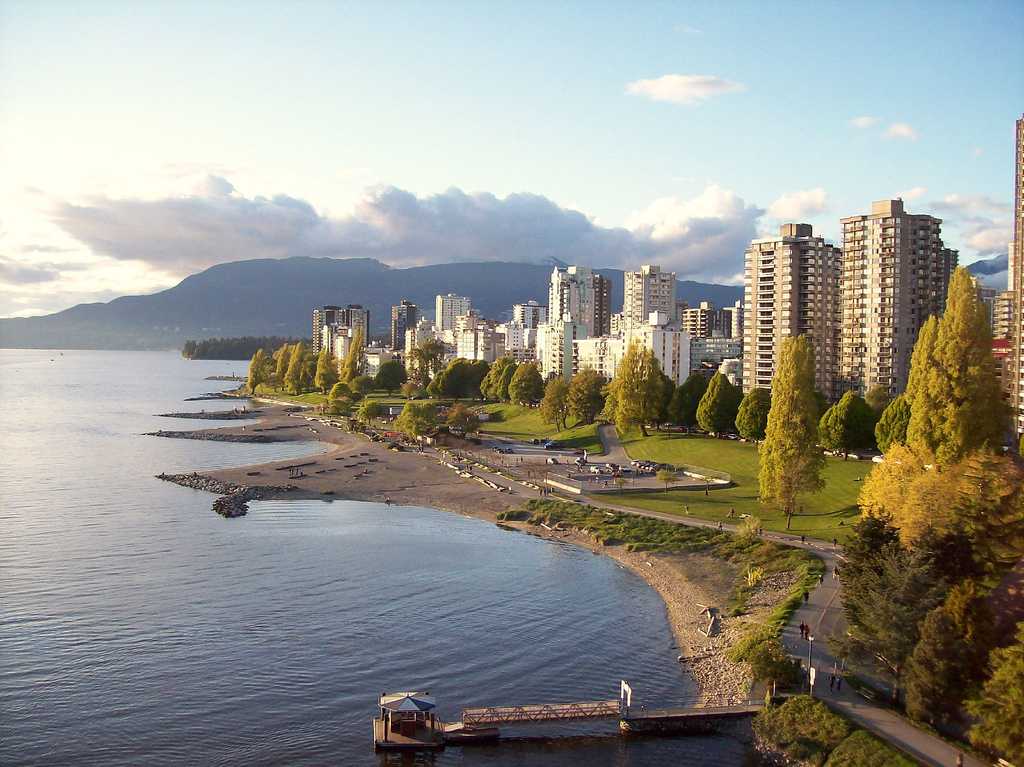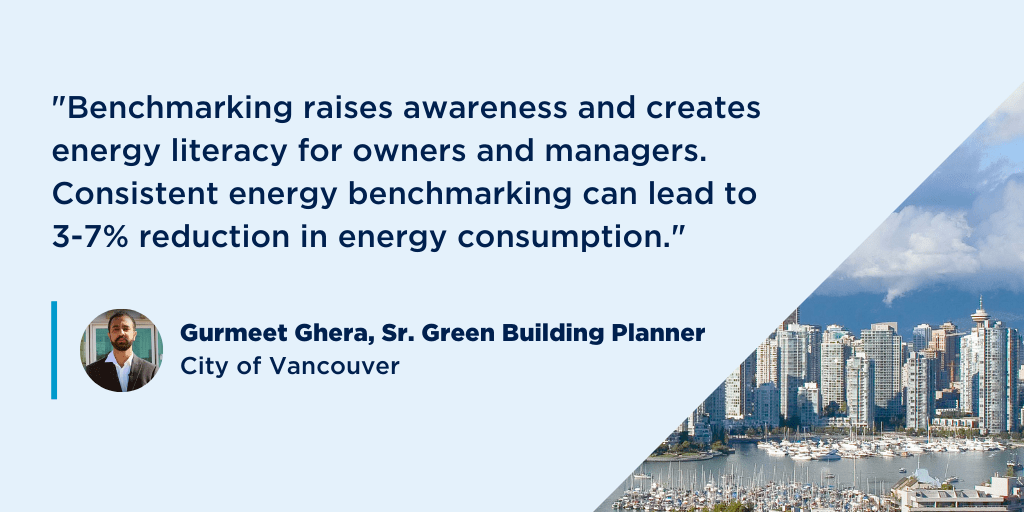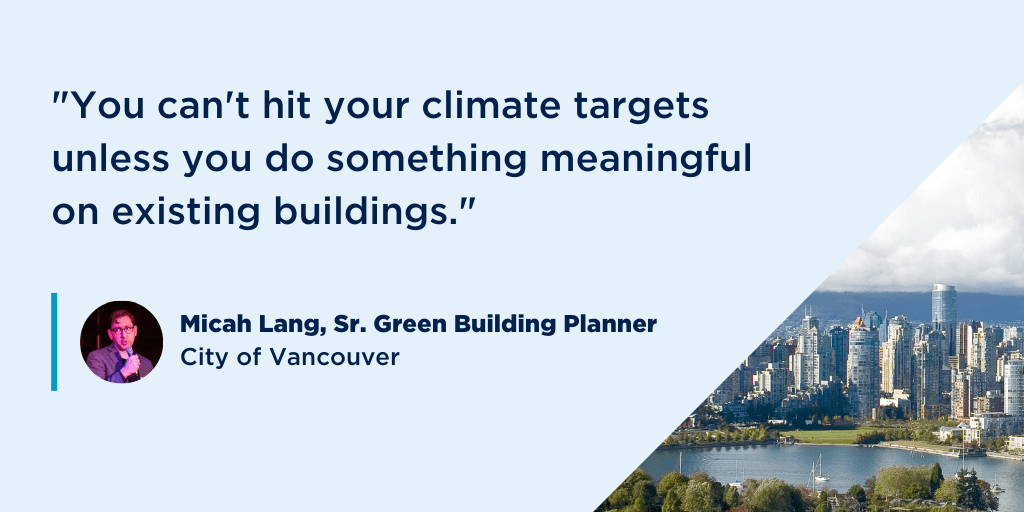Q&A with the City’s Green Buildings Team
IMT’s Manager for Policy Design and Implementation, Benjamin Silverman, collaborated with Sr. Green Building Planners Gurmeet Ghera and Micah Lang from the City of Vancouver’s Green Buildings Team, Sustainability Group, on their policy development efforts. Gurmeet and Micah answered some of our questions about the new Annual Greenhouse Gas and Energy Limits Bylaw which passed on July 20, 2022. Read more about the policy on our recent blog post.

Could you provide some context for what progress has looked like in regards to buildings in Vancouver?
Micah Lang: Two years ago, the City declared a climate emergency, and the council approved an action plan which had very specific existing building strategy. The plan directed staff to draft energy benchmarking regulation and carbon pollution limit for large existing buildings. There’s a model national building code in Canada which provinces then adopt. The vast majority of local governments in Canadian cities follow these provincial building codes. Vancouver is unique because we have charter authority to determine our own building code. That gives us the opportunity to pass legislation, both for new construction as well as existing buildings to more rapidly reduce greenhouse gas emissions. Over the past 15 years, Vancouver has been a leader in Canada and in North America in terms of new building construction standards.
Gurmeet Ghera: Now with the carbon pollution limits that council passed in June 2022, Vancouver has entered the realm of being a leader in the existing building space as well. Vancouver is the second municipality, third jurisdiction, and first in Western Canada to require annual energy and carbon reporting.
What were your roles in initiating and passing this bylaw?
Gurmeet: Micah has been leading the policy development for the carbon pollution limits, laying the groundwork, and talking to industry. When I came on board, I started looking into the development of the energy benchmarking policy. The two regulations are very closely related: benchmarking is the first step, followed by carbon pollution limit. Data will be derived from the benchmarking to inform the carbon pollution limits regulation. I built on our relationships with the industry leaders, key stakeholders, and the utilities because we needed smooth data transfer around energy consumption from these ~1,500 buildings that would be required to report their data. All that groundwork of determining what makes sense, how strict are we going to be with the compliance, whether there will be a monetary penalty or not, what kind of support services will be required by these buildings to come under compliance—all those phases and different parts were designed by us and our consultants.
Micah: I also want to call out that over the past four years, we’ve had a number of consultant studies inform the development of this bylaw. The most recent being with IMT as part of the team. That study was focused on how to establish a baseline building performance and to set future limits for greenhouse gas intensity limits based on the existing data, which, this is the first time that a city has set limits for existing buildings without having benchmarking data first.

How did you incorporate community priorities into this new bylaw?
Micah: An emerging priority is how we get cooling in our existing building stock, especially residential properties like condos and multi-family buildings. Historically, buildings in Vancouver have not had cooling in them, but we had an unprecedented heat wave last summer—the heat dome—and the summers have been getting warmer. We had a team of folks involved in stakeholder engagement, four internal staff at the city who were actively involved in the bylaw development. Plus, consultants who supported that engagement. We had an external advisory committee who followed the journey over the course of nine months. Then we had a two month long, broader stakeholder engagement period to socialize these draft regulations before bringing the final recommendations to council to approve.
Gurmeet: We have factored equity considerations into developing these regulations, especially when it comes to support services for buildings pursuing compliance. For example, an office tower will have more resources and technical capacity to determine how their building is performing and how to provide that data to the city when the regulation goes into effect. But a multi-family building, may or may not have access to resources like a property management company who can help the owner comply. Our support services will be more focused on helping those buildings by providing one-on-one support to create a building profile and submit data.
Are there any challenges or accomplishments you want to highlight?
Gurmeet: Benchmarking raises awareness and creates energy literacy for owners and managers. This bylaw will provide a level of comparison, so they can see how they measure against similar buildings in the city. Consistent energy benchmarking can lead to 3-7% reduction in energy consumption. Some challenges we faced on the benchmarking side: these regulations, they cover a lot of buildings. It’s not like we’re covering 10 or 20 buildings, right? It’s always in the thousands. Getting accurate data from the utilities is always a key consideration. We’ve seen in some jurisdictions where owners cannot get energy data directly from the utility, although systems such as Portfolio Manager web services can make compliance much easier. Another challenging component is disclosure of data. We discussed with the industry and some stakeholders supported disclosure of individual building level data, and some opposed, so we are doing voluntary disclosure.
Micah: Looking across North America, buildings comprise of between 35% and 70% of a city’s GHG emissions. In Vancouver we’re at about 60%. You can’t hit your climate targets unless you do something meaningful on existing buildings. On the new construction side, you’re at most impacting 1% or so of emissions on an annual basis through your new construction standards. You have to have building performance standards or regulations on existing buildings if the city is committed to taking climate action, because otherwise most cities can’t impact their grid. Building performance standards is sort of a win-win. It provides maximum flexibility for large buildings, which are complex and unique and gives them the ability to design a plan that makes sense for their building. It also provides predictability and aids in planning for upgrades. Most cities can’t impact energy supply. They need to work with their local building owners to own building performance. That’s the space where cities can really make a difference in existing building GHG emissions.

Do you have any advice that you would give to other municipalities or provinces in Canada?
Gurmeet: One suggestion is municipalities should check their authority when it comes to collecting this data. The timelines on verifying or getting that authority can sometimes be long and could affect the implementation of the project. It’s also good to talk to other jurisdictions that have such programs in place already. IMT was a good resource for that as well. We’ve talked to the city of Seattle and Province of Ontario. Some things might not be applicable to your jurisdiction, so you can filter those suggestions according to your needs.
Micah: In jurisdictions where there may not be full or clear political support, industry can be a real ally. If you look for the leaders and work closely with building owner associations and industry groups, as well as community groups, then you’re able to put together this cohort of allies for this work. If your engagement process is inclusive and they feel bought into it, then that’s a really strong voice to bring forward once you’re bringing recommendations in front of elected officials. If there are any doubts, misconceptions, or misunderstandings about what these regulations entail, a broad cross-section of your community, including the biggest companies that own buildings, can call for action.
